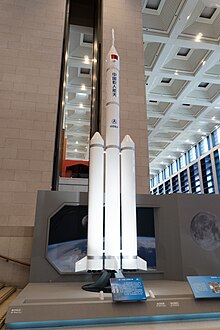 1:10 scale model of the Long March 10 at the National Museum of China | |
| Function | Super heavy-lift launch vehicle |
|---|---|
| Manufacturer | China Academy of Launch Vehicle Technology |
| Country of origin | |
| Size | |
| Height | 92.5 m (303 ft)[1] |
| Diameter | 5.0 m (16.4 ft) |
| Mass | 2,189,000 kg (4,826,000 lb)[1] |
| Stages | 3 |
| Capacity | |
| Payload to Low Earth orbit | |
| Mass | 70,000 kg (150,000 lb) |
| Payload to Trans-lunar injection | |
| Mass | 27,000 kg (60,000 lb) |
| Associated rockets | |
| Family | Long March (rocket family) |
| Comparable |
|
| Launch history | |
| Status | In development |
| Boosters | |
| No. boosters | 2 |
| Diameter | 5 m (16 ft) |
| Propellant mass | 520,000 kg (1,150,000 lb) |
| Powered by | 7 YF-100K |
| Maximum thrust | Sea level: 8,750 kN (1,970,000 lbf) Vacuum: 9,772 kN (2,197,000 lbf) |
| Total thrust | Sea level: 17,500 kN (3,900,000 lbf) Vacuum: 19,544 kN (4,394,000 lbf) |
| Specific impulse | Sea level: 301.6 s (2.958 km/s) Vacuum: 337 s (3.30 km/s) |
| Burn time | 173 seconds[2] |
| Propellant | RP-1 / LOX |
| First stage | |
| Diameter | 5 m (16 ft) |
| Propellant mass | 680,000 kg (1,500,000 lb) |
| Powered by | 7 YF-100K |
| Maximum thrust | Sea level: 8,750 kN (1,970,000 lbf) Vacuum: 9,772 kN (2,197,000 lbf) |
| Specific impulse | Sea level: 301.6 s (2.958 km/s) Vacuum: 337 s (3.30 km/s) |
| Burn time | 227 seconds[2] |
| Propellant | RP-1 / LOX |
| Second stage | |
| Diameter | 5 m (16 ft) |
| Propellant mass | 185,000 kg (408,000 lb) |
| Powered by | 2 YF-100M |
| Maximum thrust | 2,920 kN (660,000 lbf) |
| Specific impulse | 352.3 s (3.455 km/s) |
| Burn time | 215 seconds[2] |
| Propellant | RP-1 / LOX |
| Third stage | |
| Diameter | 5 m (16 ft) |
| Propellant mass | 59,000 kg (130,000 lb) |
| Powered by | 3 YF-75E |
| Maximum thrust | 276.3 kN (62,100 lbf) |
| Specific impulse | 451.1 s (4.424 km/s) |
| Burn time | 924 seconds[2] |
| Propellant | LH2 / LOX |
Long March 10[3] (Chinese: 长征十号), also known as the “Next Generation crewed launch vehicle” (Chinese: 新一代载人运载火箭), and previously and unofficially as the “921 rocket” (Chinese: 921火箭) or the "Long March 5G" (a development of the Long March 5), is a Chinese super-heavy carrier rocket for crewed lunar missions that is currently under development. The nickname "921" refers to the founding date of China's human spaceflight program. In 2022, the first flight was targeted for 2027.[4] By 2024, the first flight's target was moved up to 2025–26.[citation needed] In April 2024, it was announced that program development was complete.[5]
The standard Long March 10 will be capable of lifting 70 tonnes into low Earth orbit (LEO) and 27 tonnes into trans-lunar injection trajectories.[6]
There are also plans for a variant, the Long March 10A,[7] which is designed primarily for future low Earth orbit crew and cargo transport to the Chinese Space Station. It will be partially reusable and capable of lifting at least 14 tonnes into LEO.[6]
- ^ a b "我国新一代载人运载火箭长征十号完成一子级火箭动力系统试车". 中国载人航天工程官方网站. 2024-06-14. Archived from the original on 2024-06-16. Retrieved 2024-06-16.
- ^ a b c d 王聪; 王劲博; 宋征宇 (2023). "登月火箭剩余运载能力估计与停泊轨道重规划". 宇航学报. 44 (9): 1323.
- ^ 汪淼 (2023-02-24). "我国新一代载人运载火箭命名为"长征十号",将用于登月任务" (in Simplified Chinese). IT之家. Retrieved 2023-02-25.
- ^ Jones, Andrew (11 November 2022). "China's huge new crew-launching moon rocket could fly for 1st time in 2027". Space.com. Retrieved 18 November 2022.
- ^ Jones, Andrew (24 April 2024). "China on track for crewed moon landing by 2030, space official says". SpaceNews. Retrieved 24 April 2024.
- ^ a b Jones, Andrew (6 March 2022). "China wants its new rocket for astronaut launches to be reusable". Space.com. Retrieved 5 October 2023.
- ^ https://twitter.com/CNSpaceflight/status/1677895887153160193